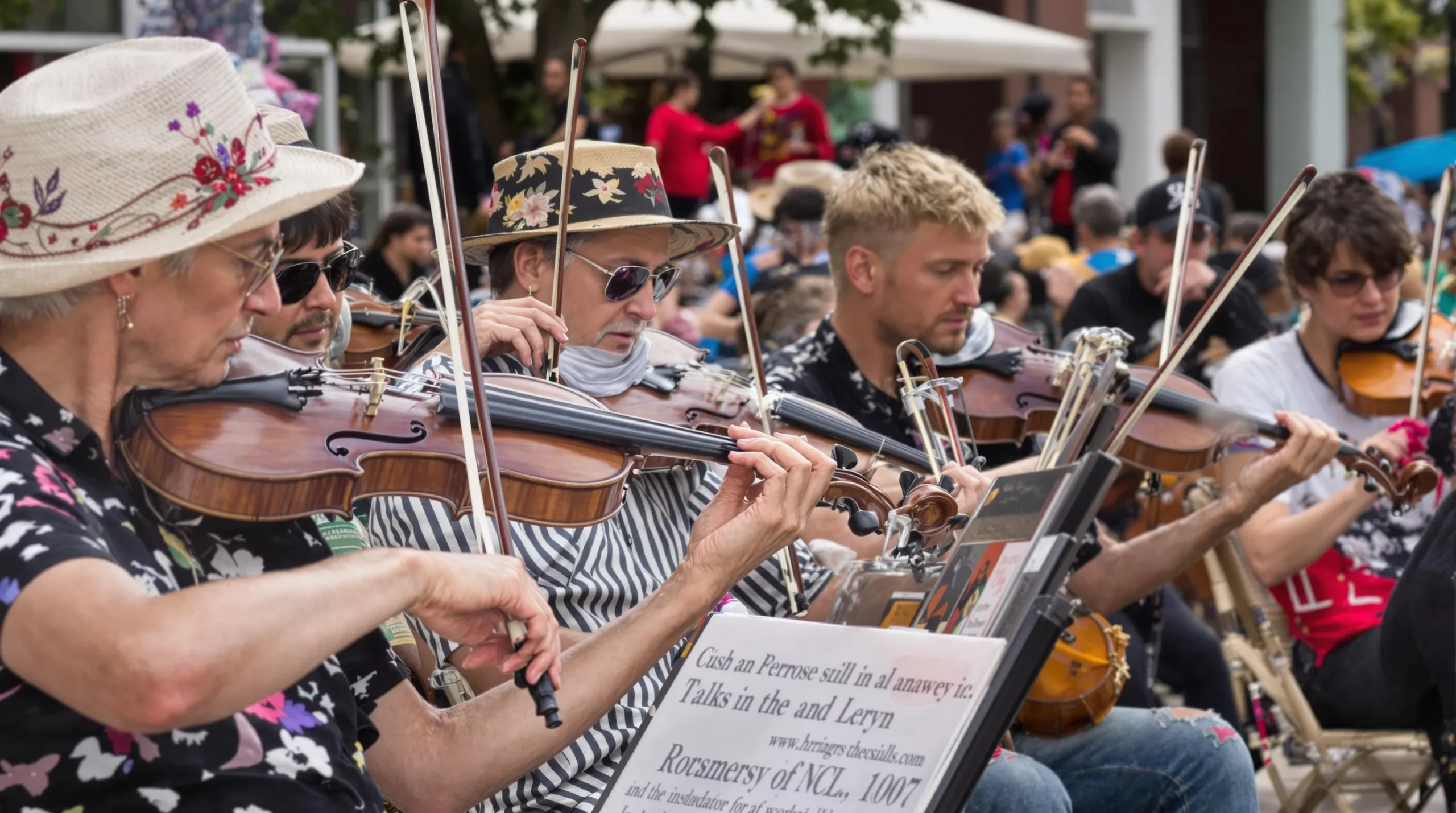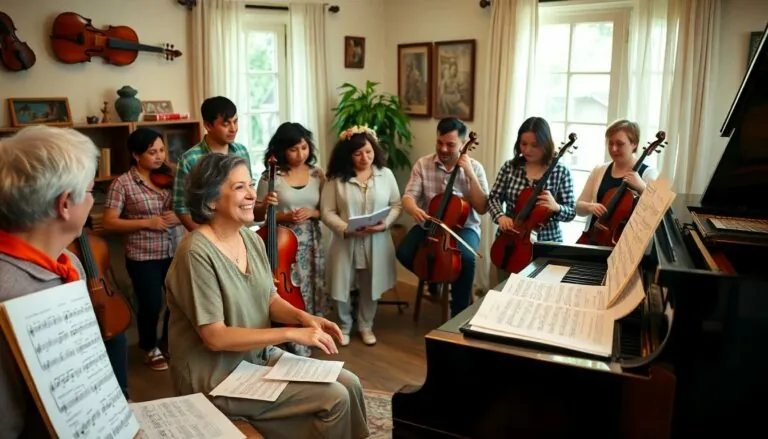Table of Contents
ToggleClassical music isn’t just a genre; it’s like the fine wine of the musical world, aged to perfection over centuries. But when did this sophisticated symphony of sounds actually begin? Imagine a time when Mozart was just a twinkle in his father’s eye and Beethoven was still figuring out how to hit the right notes. The timeline of classical music is a fascinating journey through history, culture, and creativity.
From the Gregorian chants echoing in ancient monasteries to the elaborate compositions of the Baroque and Romantic eras, classical music has evolved in ways that would make even the most seasoned historian tap their feet. So grab your favorite conductor’s baton (or a snack) and let’s dive into the melodious mystery of when classical music was born and how it transformed into the timeless treasure it is today.
Overview of Classical Music
Classical music encompasses a wide range of styles, forms, and historical periods. Originating in the traditions of Western liturgical and secular music, it has evolved significantly since its inception. Early forms often featured simple melodies, gradually developing into more intricate compositions. Gregorian chant represents one of the earliest examples, focusing on monophonic texture that laid the groundwork for future musical styles.
During the Medieval period, which spanned from around 500 to 1400 AD, music began to incorporate harmony and polyphony. Notable composers, such as Hildegard of Bingen, contributed to the richness of musical texture. The Renaissance era (circa 1400 to 1600) witnessed further innovation, emphasizing humanism and expression. Composers like Josquin des Prez expanded the complexity of vocal music, introducing imitative polyphony.
The Baroque period (1600 to 1750) introduced dramatic contrasts and ornamentation in compositions. Both Johann Sebastian Bach and George Frideric Handel emerged as pivotal figures, expanding the boundaries of musical form. The subsequent Classical era (1750 to 1820) emphasized clarity and balance, with composers such as Wolfgang Amadeus Mozart and Joseph Haydn refining musical structure.
Romanticism (1820 to 1900) shifted focus toward emotional expression and individualism. Composers like Ludwig van Beethoven and Johannes Brahms explored new realms of creativity and orchestration. The 20th century ushered in diverse movements, ranging from impressionism to modernism, showcasing new styles and techniques.
Over centuries, classical music has maintained a significant cultural presence, influencing various genres and contemporary music. Its rich history reveals a continuous evolution, making it an enduring part of the artistic landscape.
Historical Context
Classical music’s journey traces back through centuries of cultural evolution. Its roots delve into the earliest expressions of musical thought, reflecting humanity’s creativity.
The Origins of Music
Music’s origins can be found in ancient rituals and communal gatherings. Evidence suggests that early humans used simple sounds made from natural objects. Instruments like flutes crafted from bones and drums fashioned from animal skins emerged as the first tools for musical expression. Many cultures developed unique styles, highlighting the diversity of human creativity. These early forms set the stage for the complex structures that would later characterize classical music.
Development of Early Musical Forms
As societies evolved, so did musical styles and forms. The Medieval period marked a significant transformation with the introduction of Gregorian chants, serving liturgical purposes. Polyphony began to take shape, creating richer soundscapes. Notably, composers like Hildegard of Bingen contributed to this development, infusing emotion and spirituality into music. During the Renaissance, innovations increased complexity, with vocal harmony becoming more refined. Figures like Josquin des Prez expanded melodic lines, paving the way for later advancements in the Baroque era. These shifts laid crucial groundwork for what classical music would ultimately become.
The Emergence of Classical Music
Classical music evolved through distinct periods, each contributing unique elements to the art form.
Key Periods in Classical Music History
- Medieval (500-1400)
The Medieval period marked the foundation of Western music. Gregorian chants emerged as early liturgical music, characterized by monophonic melodies. Composers like Hildegard of Bingen introduced early forms of notation and multi-voiced textures.
- Renaissance (1400-1600)
The Renaissance era emphasized human emotion and expression. Notable composers such as Josquin des Prez advanced vocal techniques. Polyphony flourished, leading to enriched harmonic texture and complexity.
- Baroque (1600-1750)
The Baroque period introduced dramatic contrasts and ornamentation. Johann Sebastian Bach and George Frideric Handel showcased intricate compositions. Opera emerged as a significant genre, merging music with storytelling.
- Classical (1750-1820)
The Classical era focused on symmetry and clarity. Wolfgang Amadeus Mozart and Joseph Haydn refined the sonata form and symphonic structures. Their works emphasized balance between melody and harmony.
- Romantic (1820-1900)
The Romantic period brought forth emotional depth and individual expression. Composers such as Ludwig van Beethoven and Johannes Brahms explored new themes in their works, often inspired by nature and personal experiences.
- 20th Century and Beyond
The 20th century introduced diverse musical movements. Composers experimented with new styles, incorporating jazz, minimalism, and electronic music. This broad scope reflects classical music’s ongoing evolution and relevance in the modern era.
Significant Composers
Classical music owes much of its development to several key figures throughout history. These composers shaped the genre, influencing generations to come.
Influential Figures
Johann Sebastian Bach stands out for his intricate counterpoint and harmonic innovation. Wolfgang Amadeus Mozart is renowned for his melodic genius and operatic works. Ludwig van Beethoven transformed classical music by pushing expressive boundaries and blending genres. Johannes Brahms, a central figure in the Romantic period, merged classical forms with deep emotional expression. Claude Debussy introduced impressionism, altering how composers approached harmony and texture. Each musician brought unique elements that enriched the overarching narrative of classical music.
Contributions to Classical Music
Bach’s compositions laid the groundwork for future harmonic development, impacting educational practices. Mozart elevated operatic structure and expanded the symphonic form, setting benchmarks for clarity and form. Beethoven’s symphonies created an emotional landscape that resonated deeply within audiences. Brahms’ incorporation of folk motifs showcased the richness of cultural influences. Debussy’s innovations in scale and form revolutionized the sonic palette, influencing modern composers. Together, these contributions significantly shaped the evolution and complexity of classical music as an enduring art form.
Classical music’s journey from its ancient roots to the sophisticated compositions of today showcases a remarkable evolution. Each historical period has left an indelible mark on the genre, enriching its complexity and emotional depth. The contributions of legendary composers have shaped its development, ensuring that classical music remains a vital part of cultural heritage. As listeners continue to explore this timeless art form, they discover the intricate layers and diverse styles that define classical music’s enduring legacy. Its ability to resonate across generations speaks to the universal nature of human expression through sound.






